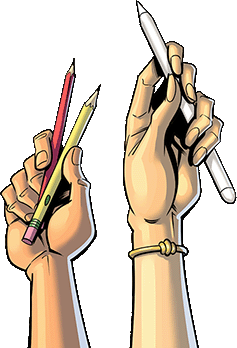Comic Book Publishing Made Easy
Posted by Mary MacInnes on May 21, 2020
Comic books and graphic novels are an integral part of our cultural landscape. The characters and plots have been around for the better part of a century. Batman, Superman, and Wolverine would have never made it to the big screen if they hadn't first appeared in comic books.
If you're creating a comic book and are looking to publish, you have a lot of options. E-printing and e-publishing services have made it easy for a comic creator to create both print and digital renditions of your story.
Once you have your ideas saved to a file and a basic layout of your comic sketched out in rough draft form, choose the formatting options that align with the themes of your comic.
Types of Paper
There are numerous options for paper. You can opt for uncoated, cheaper paper for the inside of your comic or heavier, more expensive glossy pages for your comic book cover. There are pros and cons to each option.
If you choose glossy paper, which weighs more than uncoated paper, your readers will be awed by the high quality and precise inking. Glossy pages make the finished product substantial and durable, but they can also make the comic book so heavy that it is a pain to carry.
On the other hand, uncoated pages are cost-effective, helping you allocate more resources to the show-stopping cover and back cover. However, these pages wear more quickly than coated pages and can tear.
You also have the choice between full-color layouts or stark black-and-white. With uncoated paper, you can choose between the two; however, some glossy pages only print in full-color.

Page Size
Although there is no de-facto industry standard, most comic books are between 5.5" x 8.5" or 5.5" x 11.5". This is the classic comic book-sized option.
If you choose a different shape or size of the paper, your comic may stand out from the others on the shelves, but production is also costlier.
Binding
For binding format, the author can choose between a saddle-stitched binding or a perfect bound binding.
In general, comic books have saddle-stitched bindings, and graphic novels have perfect bound bindings. The former is held together with staples and is transportable and sleek. The latter has a covered, edged binding that sits well on a bookshelf.
Publishing
After you've made these formatting decisions, you can publish your comic book. For that, you'll need expert guidance from a company like Comix Well Spring that has years of experience.
Comix Well Spring specializes in end-to-end comic book publishing. With 7,000 customers across the globe, we have the expertise and attention to detail to make your dream comic book a reality.
Our excellent customer service guarantees that you never feel as if you're in the process alone. We are there for every step in the process.
Selling
There are as many marketing options as there are publishing options. With social media and print-on-demand options, you have several different avenues in terms of getting the word out about your comic book. That being said, selling your comic book isn’t always easy.
A comic book convention, local library events, and your hometown bookstore are all superb places to start networking, and you should do so well before you get your hands on the finished product.
Remember, you're selling to readers, not to big-name publishers. Use digital platforms or hit the bricks to get to know your fans and let them get to know you.

Last Word
With Comix Well Spring, you're in excellent hands. We have years of experience and thousands of clients worldwide.
The publishing world can be complicated and confusing, and it is incredibly beneficial to your burgeoning career that you have guidance in the nascent stages. Contact Comix Well Spring to start your journey to being the comic book author you've always dreamed of becoming.


